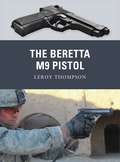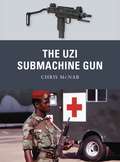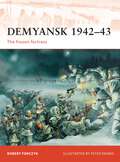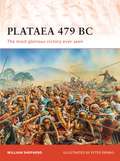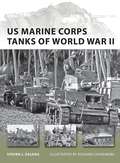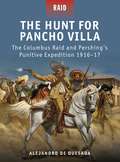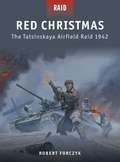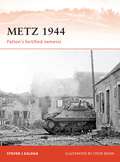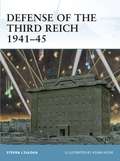- Table View
- List View
The Beretta M9 Pistol (Weapon #11)
by Leroy Thompson Johnny Shumate Alan GillilandIn 1990 the Beretta M9 replaced the venerable Colt 1911 as the main pistol of choice for the US Army, and it has seen widespread use in Iraq and Afghanistan. Written by a leading pistol expert who currently trains US Special Forces in the use of this weapon, this book is an honest appraisal of the successes and failings of the 9mm Beretta. The volume traces the Beretta designs that preceded the M9, as well as its use on the battlefield, including the impact it has had on close combat training due its the larger magazine capacity. It also details the adoption of the Beretta by US law enforcement agencies and the impact this has had. This is a fascinating history of a classic pistol and an assessment of its future use.
The New Zealand Expeditionary Force in World War I (Men-at-Arms)
by Mike Chappell Wayne StackThe New Zealand Expeditionary Force earned an elite reputation on the Western Front In World War I, and the New Zealanders' war effort was a defining moment in their national history. The statistics are astonishing: of the total population of New Zealand of 1 million, no fewer than 100,000 men enlisted, and of those, 18,000 were killed and 58,000 wounded. In other words, 15 percent of the male population of New Zealand became casualties. Famously, the NZEF was first committed at Gallipoli in 1915, but NZ cavalry regiments also helped defend Egypt and fought in Palestine with Allenby's famous Desert Mounted Corps. On the Western Front the Kiwis were called the 'Silent Division' for their fieldcraft and their uncomplaining professionalism. This book is both a tribute and a history of the contribution made by a small nation.
The Uzi Submachine Gun (Weapon)
by Johnny Shumate Chris McNab Alan GillilandThe Uzi submachine gun is one of the most recognizable weapons in history. Its familiarity stems in part from the sheer diversity of its users. Uzis have been seen being wielded and fired by US Secret Service agents and SWAT teams, Israeli soldiers, European special-forces, as well as criminals and terrorists the world over. The reasons they use the Uzi are simple – it provides devastating close-range firepower in a reliable, highly compact weapon. Weapon: The Uzi Submachine Gun tells the story of this unique weapon. It not only explores the gun's technical development and specifications, but also describes the and analyzes Uzi's combat use in a wide range of contexts, from Israeli soldiers battling on the Golan Heights in 1967, through to modern pirates operating off the coast of Somalia. This book presents the facts and challenges the myths surrounding this remarkable weapon.
Demyansk 1942–43: The frozen fortress (Campaign #245)
by Peter Dennis Robert ForczykThe fighting around the town of Demyansk was one of the longest encirclement battles on the Eastern Front during World War II, stretching from February 1942 to February 1943. Originally, the German 16. Armee occupied Demyansk in the autumn of 1941 because it was key terrain that would be used as a springboard for an eventual offensive into the Valdai Hills. Instead, the Soviet winter counteroffensive in February 1942 encircled the German II Armeekorps and other units, inside the Demyansk Pocket. Yet despite severe pounding from five Soviet armies, the embattled German troops held the pocket and the Luftwaffe organized a major aerial resupply effort to sustain the defenders. For the first time in military history, an army was supplied entirely by air. In February 1943, Marshal Timoshenko was ordered to launch an offensive to cut off the base of the salient and annihilate the 12 divisions. At the same time, Hitler finally came to his senses after the Stalingrad debacle and authorized the 16. Armee to withdraw from the pocket. This volume will conclude with the drama of a German Army-sized withdrawal under fire in winter, under attack from three sides.
Plataea 479 BC: The most glorious victory ever seen (Campaign #239)
by Peter Dennis William ShepherdPlataea was one of the biggest and most important land battles of pre-20th century history. Close to 100,000 hoplite and light-armed Greeks took on an even larger barbarian army that included elite Asian cavalry and infantry, and troops from as far away as India, with thousands of Greek hoplites and cavalry also fighting on the Persian side. At points in the several days of combat, the Persians with their greater mobility and more fluid, missile tactics came close to breaking the Greek defensive line and succeeded in cutting off their supplies. But, in a fatal gamble when he nearly had the battle won, their general Mardonius committed the cream of his infantry to close-quarters combat with the Spartans and their Peloponnesian allies. The detailed reconstruction of this complex battle draws on recent studies of early 5th-century hoplite warfare and a fresh reading of the ancient textual sources, predominantly Herodotus, and close inspection of the battlefield.
Georgy Zhukov (Command)
by Robert Forczyk Adam HookZhukov was the dominant figure in the Red Army during World War II even though his actual job title varied from day to day. Serving as a senior General Staff representative from the Stavka, Zhukov moved from one critical sector to the next, serving as advisor, coordinator and de facto front commander as required. There is no doubt that Zhukov played a critical role in salvaging the critical situation in the autumn of 1941 and leading the Red Army to an amazing reversal of fortunes in 1942–43 and eventual victory in 1944–45. However, Zhukov's methods were brutal and contributed to massive Soviet casualties, while he continued to keep his hand in political affairs as well. As the most recognized Soviet soldier of World War II, Zhukov's post-war fall from grace was precipitous and it was not until the fall of the Soviet Union that his reputation was restored. This book presents a analysis of Zhukov's military career, highlighting the strategies and tactics that made him such as successful military leader.
US Marine Corps Tanks of World War II (New Vanguard)
by Steven J. Zaloga Richard ChasemoreDuring World War II, the US Marine Corps formed six tank battalions that battled through the harsh conditions of the Pacific Theatre. Using the same basic tanks as the US Army, notably the M3 and M5A1 light tanks and the M4 Sherman medium tank, the marines made both technical and tactical innovations to make them more effective in the fight against the Japanese. Deep wading equipment, flamethrower tanks, and even wooden armor all became part of the Marine arsenal. This book examines the tactics and technology that made the US Marine Corps tank service unique in the annals of warfare.
Imperial Japanese Navy Light Cruisers 1941–45 (New Vanguard)
by Paul Wright Mark StilleThe Imperial Japanese Navy went to war with 17 light cruisers and another three cruiser-sized training ships. Of these, most were 5,500-ton ships designed to act as destroyer squadron flagships. This made them much different in capabilities and mission from their American counterparts. During the war, the Japanese built another five light cruisers, all but one of which maintained the design premise of being able to serve as destroyer squadron flagships. During the war, Japanese light cruisers were active throughout the Pacific performing many missions in addition to their flagship duties. Mark Stille continues Osprey's coverage of the IJN of WWII with this concise and complete study of all 25 ships, from their design and development to their ultimate fates. Detailed Osprey artwork and rare period photographs from the Fukui collection held in Kure, Japan illustrate this discussion.
Great Lakes Warships 1812–1815 (New Vanguard)
by Paul Wright Mark LardasWhen war broke out in 1812, neither the United States Navy nor the Royal Navy had more than a token force on the Great Lakes. However, once the shooting started, it sparked a ship-building arms race that continued throughout the war. This book examines the design and development of the warships built upon the lakes during the war, emphasising their differences from their salt-water contemporaries. It then goes onto cover their operational use as they were pitted against each other in a number of clashes on the lakes that often saw ships captured, re-crewed, and thrown back against their pervious owners. Released in 2012 to coincide with the 200th anniversary of the outbreak of the war, this is a timely look at a small, freshwater naval war.
Tomahawk and Musket: French and Indian Raids in the Ohio Valley 1758 (Raid)
by Peter Dennis Johnny Shumate René Chartrand Donato SpedaliereIn 1758, at the height of the French and Indian War, British Brigadier General John Forbes led his army on a methodical advance against Fort Duquesene, French headquarters in the Ohio valley. As his army closed in upon the fort, he sent Major Grant of the 77th Highlanders and 850 men on a reconnaissance in force against the fort. The French, alerted to this move, launched their own counter-raid. 500 French and Canadians, backed by 500 Indian allies, ambushed the highlanders and sent them fleeing back to the main army. With the success of that operation, the French planed their own raid against the English encampment at Fort Ligonier under less than fifty miles away. With only 600 men, against an enemy strength of 4,000, he ordered a daring night attack on the heart of the enemy encampment. This book tells the complete story of these ambitious raids and counter-raids, giving in-depth detail on the forces, terrain, and tactics.
The Hunt for Pancho Villa: The Columbus Raid and Pershing’s Punitive Expedition 1916–17 (Raid #29)
by Peter Dennis Johnny Shumate Donato Spedaliere Alejandro De QuesadaOn March 9, 1916, troops under the command of Pancho Villa attacked Columbus, New Mexico and its local detachment of the US 13th Cavalry Regiment, killing 18 people and burning the town. Six days later, on orders from President Woodrow Wilson, General John J. "Black Jack†? Pershing led an expeditionary force of 4,800 men into Mexico to capture Villa. What followed was a series of skirmishes, battles, and chases through the wild and uncharted Mexican countryside. While the Americans failed in their ultimate purpose of catching Villa, they did kill two of his top lieutenants. This book charts the progress of the entire enterprise, covering the dusty marches and the bitter gunfights in the streets of small border towns, analyzing the successes and failures of this unique military expedition.
Run The Gauntlet: The Channel Dash 1942 (Raid)
by Howard Gerrard Ken Ford Paul Wright Alan GillilandIn February 1942, three of the major ships of the German surface fleet – the battle-cruisers Scharnhorst and Gneisenau, and the heavy cruiser Prinz Eugen – stormed out of the harbour at Brest on a dramatic voyage back to Germany. Passing through the straights of Dover, the ships faced everything the Royal Air Force and the Royal Navy could throw at them. In a dramatic running fight, the ships managed to sail right under the nose of history's greatest maritime nation to reach the safety of Germany. The brilliantly executed operation brought great humiliation to the British – Hitler, who had developed the plan, had judged perfectly the reaction of the British command to the Channel Dash. This book tells the complete story of this great race, from the planning through to the repercussions of this unique Germany victory.
Tokugawa Ieyasu (Command)
by Stephen Turnbull Giuseppe RavaTowards the end of the 16th century three outstanding commanders brought Japan's century of civil wars to an end, but it was Tokugawa Leyasu who was to ensure a lasting peace. In terms of his strategic and political achievements Leyasu ranks as Japan's greatest samurai commander. Leyasu possessed the rare wisdom of knowing who should be an ally and who was an enemy, a key skill for a successful military leader. Leyasu's crowning victory at Sekigahara depended on the defection to his side of Kobayakawa Hideaki, and the absence from the scene of Ieyasu's son Hidetada serves to illustrate how just once there was a failure in Ieyasu's otherwise classic strategic vision. To establish his family as the ruling clan in Japan for the next two and a half centuries was abundant proof of his true greatness.
Forts of the War of 1812 (Fortress)
by René Chartrand Donato SpedaliereWhen war broke out between the United States and Great Britain in 1812, neither side was prepared for the conflict, as evidenced by their respective fortifications. The most sophisticated and modern fortifications were those built by the US Corps of Engineers to protect some of the main port cities. These included Fort Mifflin in Philadelphia, Fort McHenry in Baltimore and Castle William in New York. The British also heavily fortified their main harbor at Halifax and their main center of power at Quebec. However, elsewhere, especially in the interior, fortifications were old, neglected or only hastily erected. The forts at Detroit and Mackinac were much as the British had left them in 1796. This book covers all of the main fortifications of the conflict, those that faced the crashing of guns and those whose intimidation played a part in the grand strategy of the war.
Panzerjäger vs KV-1: Eastern Front 1941–43 (Duel)
by Peter Dennis Robert Forczyk Ian PalmerOn the Soviet side, based upon lessons from the Spanish Civil War, the Red Army decided to develop a heavy "breakthrough†? tank to smash enemy infantry defenses. This resulted in the KV-1 and KV-2 tanks, introduced in 1939. At the start of Operation Barbarossa, both these tanks were virtually invulnerable to the weapons of the Panzerjäger and demonstrated their ability to overrun German infantry on several occasions. This advantage gave the Red Army a window of opportunity between the fall of 1941 and the spring of 1942 to use their heavy tanks to repel the German invasion in a series of desperate counteroffensives. Yet the window of Soviet advantage was a narrow one and the duel between the Soviet KV heavy tanks and German Panzerjäger had a major impact upon the struggle for the strategic initiative in 1941-42.
The Rolls-Royce Armoured Car (New Vanguard)
by Henry Morshead David FletcherThe first Rolls-Royce armoured car was a privately owned vehicle fitted with a machine-gun and a limited amount of armour plate, used by the Royal Naval Air Service in Flanders in 1914. By 1915, nearly 100 had been built and turned over to the Army. From then on, as Sir Albert Stern said 'They searched the world for war', operating as far apart as the northwest frontier of India, the Middle East and southern Africa. The cars were fast, quiet and reliable but above all powerful. 'A Rolls in the desert is above rubies,' said Lawrence of Arabia. After World War I, the War Office continued to produce the Rolls-Royce while tinkering with the design. These further cars served all across the Empire, including in Ireland and even later Shanghai, returning for a final brief appearance in the early stages of World War II.This book tells the complete story of the Rolls-Royce Armoured Car, following its design and development as it fought from theatre to theatre during World War I and the turbulent inter-war years.
Gothic Serpent: Black Hawk Down Mogadishu 1993 (Raid)
by Johnny Shumate Clayton Chun Alan GillilandThis book tells the story of Task Force Ranger – a unit of US Rangers and Special Forces – and their attempt to capture the lieutenants of the Somali warlord Muhamed Farrah Aideed, during the 1993 United Nations' humanitarian relief mission. What started as a simple snatch-and-grab mission quickly degenerated into a desperate battle for survival when US Black Hawk helicopters were struck by rocket-propelled grenades and crashed into the streets of Mogadishu. Racing to save the crew, Task Force Ranger was surrounded by mobs of hostile Somali gunmen. The battle in the city raged all night as the better-equipped and better-trained US forces kept the nearly overwhelming numbers of Somalis at bay. Finally, battered, bloodied, and low on ammunition, the Task Force was rescued by a combined UN and US relief force and extracted to safety. Containing detailed maps and declassified information, this is a dramatic retelling of a brutal battle that had a far-reaching impact on US military policy.
Red Christmas: The Tatsinskaya Airfield Raid 1942 (Raid)
by Robert Forczyk Johnny ShumateBy December 1942, the Soviets had surrounded the German 6th Army in Stalingrad, cutting off all lines of supply except through the air. Seeking to sever this last German lifeline, Soviet Command decided to launch a raid with the entire 24th Tank Corps to seize the airfield at Tatsinskaya, the primary operating base for the German airlift efforts. On 17 December, the 24th Tank Corps advanced toward Tatsinskaya, seizing the airfield on Christmas Eve. The Soviet tankers succeeded in destroying many Luftwaffe aircraft on the ground, but afterwards found themselves isolated and out of fuel behind the German lines. Generalfeldmarschall Erich von Manstein rapidly organized a counterattack with elements of two panzer divisions, crushing most of the raiding force between 26 and 28 December. Just before the raiding force was annihilated, it received permission to abandon its heavy equipment and escape back to Soviet lines on foot. Thus, the raiders accomplished their mission of severely disrupting the airlift to Stalingrad, but at the cost of an entire tank corps.
Oldest Allies: Alcantara 1809 (Raid)
by Johnny Shumate René Chartrand Mark Stacey Alan GillilandAlthough somewhat overshadowed by Wellington's main campaign in the north, the Alcantara raid was an outstanding success. The primary objective of alarming and distracting the French forces in Spain was achieved. Furthermore, the raiders also succeeded in preventing a French incursion into Portugal and tied down one of Napoleon's best marshals. There were further raids to come, but the 1809 Alcantara raid delivered a strong, permanent message: that the Anglo–Portuguese were willing and able to strike back against the French, and that they would support their Spanish allies as much as they were able.
Metz 1944: Patton’s fortified nemesis (Campaign #242)
by Steven J. Zaloga Steve NoonGeneral George Patton's most controversial campaign was the series of battles in autumn 1944 battles along the German frontier which centered on the fortified city of Metz. In part, the problem was logistics. As was the case with the rest of the Allied forces in the European Theatre, supplies were limited until the port of Antwerp could finally be cleared. Also problematic was the weather. The autumn of 1944 was one of the wettest on record, and hardly conducive to the type of mechanized warfare for which Patton was so famous. However at the heart of the problem was the accretion of sophisticated fortifications. Metz had been fortified since ancient times, heavily rebuilt by France in the post-Napoleonic period, modernized by Germany in 1870–1914, and modernized by France during the Maginot effort in 1935–40. The Germans hoped to hold Metz with a thin screen of second-rate troops, counting on the impregnable fortifications. This book covers the entire campaign from beginning to end, offering an unbiased assessment of the success and failures of both the Allied and Axis efforts.
Defense of the Third Reich 1941–45 (Fortress)
by Steven J. Zaloga Adam HookStarting in 1940, Germany was subjected to a growing threat of Allied bomber attack. The RAF night bombing offensive built up in a slow but unrelenting crescendo through the Ruhr campaign in the summer of 1944 and culminating in the attacks on Berlin in the autumn and early winter of 1943-44. They were joined by US daylight raids which first began to have a serious impact on German industry in the autumn of 1943. This book focuses on the land-based infrastructure of Germany's defense against the air onslaught. Besides active defense against air attack, Germany also invested heavily in passive defense such as air raid shelters. While much of this defense was conventional such as underground shelters and the dual use of subways and other structures, Germany faced some unique dilemmas in protecting cities against night fire bomb raids. As a result, German architects designed massive above-ground defense shelters which were amongst the most massive defensive structures built in World War II.
Italian Army Elite Units & Special Forces 1940–43 (Elite)
by Pier Paolo Battistelli Johnny ShumateItalian military historian Pier Paolo Battistelli examines the elite and specialforces units of the Italian Army during World War II. This includes a vast array of troop types, including paratroopers, assault engineers, sea-landing and swimmer units, long-range recce and ski units, and even hand-picked Fascist 'Mussolini' units. It also delves into the specialist tank and armoured units that were created to emulate the German armoured units. While the Italian units discussed enjoyed mixed success, the volume draws attention to the incredibly hard fighting done by some in the deserts of North Africa and the frozen wastelands of Russia. Illustrated with rare archival photographs and specially commissioned artwork, this is a fascinating insight into a little-studied aspect of Axis forces.
The Spanish Army in North America 1700–1793 (Men-at-Arms)
by David Rickman René ChartrandLong before England established a serious presence in the New World, Spain had already established an overseas Empire. In North America, this included vast tracts of territory including most of what today comprises the states of Florida, Arizona, Nevada, New Mexico, Texas, Alabama, Illinois and California. In later years, as the British and the French came to expand their claims, they often came into conflict with the Spanish. The Spanish also played a significant part during the American Revolution, fighting against the British and drawing off forces needed to fight the Americans. This book covers all of the North American Spanish forces that fought in the campaigns of the 18th century.
The Last Ride of the James–Younger Gang: Jesse James and the Northfield Raid 1876 (Raid)
by Peter Dennis Johnny Shumate Sean McLachlanIt was the beginning of the end for the James gang. In the past ten years Frank and Jesse James had gone from unknown ex-Confederate guerrillas to the most famous outlaws in the world. A string of daring robberies of banks, trains, and stagecoaches had brought them fame, admiration, hatred, and a surprisingly small amount of wealth. In 1876 they planned their most daring raid yet-to ride hundreds of miles from their home state of Missouri to rob the First National Bank at Northfield, Minnesota. This book will tell the story of one of the most daring bank jobs in American history. With most of the gang being former bushwhackers, they used many guerrilla tactics in the planning and execution of the raid, yet failed because of poor discipline and their own fame, which meant that every town in the Midwest had their guns loaded waiting to fight off bandits.
Knight’s Move: The Hunt for Marshal Tito 1944 (Raid)
by Johnny Shumate David GreentreeOn 25 May 1944, 800 men of the 500th SS Parachute Battalion descended on Drvar, a town behind enemy lines in north-western Bosnia. Their aim was to kill or capture Tito, the leader of the partisan movement in the region. The plan was to land the battalion by glider and parachute in two waves which would be relieved the next day by a ground assault. Tito knew an attack was imminent but dismissed the idea of an airborne assault. The attempt to eliminate Tito was a colossal failure. The elite battalion had been decimated, with only 200 men fit for duty the next day. Inter-agency rivalry between the Abwehr and the SS had meant that intelligence was not shared, a problem exacerbated by a failure to exploit HUMINT about Tito's precise location and the adoption of a plan that did not take into account these intelligence limitations.
